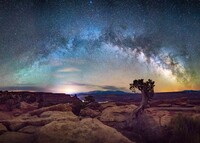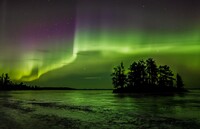By Candyce H. Stapen
Treat yourself and your family to a dazzling night sky ablaze with stars, planets and nebulae, a sight most people now see only on their computer screens. Instead of being one of the estimated 80% of Americans who cannot view the Milky Way from their homes, time-travel back to an era of star-studded heavens that beguiled ancient civilizations.
DarkSky International has certified more than 200 dark sky parks, preserves and communities worldwide, places that limit light pollution through various measures. As a result, their skies glow with an awe-inspiring brilliance. Simply gaze up to gather the wonder.
To best enjoy the mythic night skies, choose a moonless night with few clouds, use a flashlight equipped with a red filter that doesn't hamper astrological viewing and bring binoculars to spot fainter formations. The best time to view heavenly displays is often — but not always — winter, with its longer nights and lower humidity, which reduces haze. On cold evenings, wear layers to stay warm and be patient, as it can take 15 minutes for your eyes to adjust. For an added bonus, time your visit to coincide with a park's stargazing special events.
In northern Minnesota, Voyageurs National Park, an International Dark Sky Park, sweeps across 218,000 acres of lakes, streams and forests. In summer, canoeists paddle and portage through the waters. Winter brings ice-fishing, snowshoeing, cross-country skiing and great visibility for displays of the Northern Lights (Aurora Borealis), a vivid spectacle of green and purple bands of light dancing across the night sky.
In Voyageurs, summer rates as the best time to see the Milky Way, but the park rewards stargazing year-round. Pick an open field, a clearing or a dock that affords an expanse of sky. During Minnesota's Boreal Stargazing Week, slated for Feb. 12-27, 2026, view the heavens through the park's telescopes.
The morning sun turns the Grand Canyon's rock walls orange and red, and in the evening, as the light wanes, they morph to deep blues and purples. At night in Arizona's Grand Canyon National Park, an International Dark Sky Park, the constellations pop and glow. The clear air and 7,000-foot elevation of the South Rim make for excellent stargazing conditions. Walk beyond the reach of the lodges' lights or head to Yavapai, Lipan and Mather points. Throughout the year, rangers offer astronomy talks and other events. Grand Canyon, an authorized park concessioner, offers stargazing packages.
Adjacent to Canyonlands National Park, Dead Horse Point State Park, Utah, is known for its cliffs, canyons, snaking river and starry night skies. The International Dark Sky Park's location on a high mountain plateau affords wide vistas of sparkling skies. At select times the park offers evening walks, telescope viewing and talks. Movie buffs may want to visit "Thelma and Louise Point," the unofficial name of the overlook where the two main characters in the movie "Thelma and Louise" drove their car over a cliff.
Great Basin National Park, an International Dark Sky Park in east-central Nevada, encompasses more than 77,000 acres that include caves, stands of 4,000-year-old bristlecone pine trees and night skies that are among the darkest in the contiguous 48 states. The reason is mountains that block light pollution from the outlying large cities. In summer, a popular time to visit, look for the shimmering Milky Way, glowing planets, artificial satellites and even the Andromeda Galaxy.
From Memorial Day to Labor Day the park hosts astronomy programs at its Astronomy Amphitheater. In addition, consider boarding the Nevada Northern Railway's Great Basin Star Train, an especially convenient option for families with young children. From mid-May through mid-September the train chugs through nearby territory outside the park. Rangers who come along on the round-trip journey from Ely, Nevada, explain the heavenly show. The train pauses at Star Flats, a remote desert location, allowing riders to gaze through telescopes at the dazzling dark skies.
Don't miss an International Dark Sky Park adventure. The experience delivers magical, awe-inspiring delight.
WHEN YOU GO
DarkSky International: darksky.org.
Voyageurs Conservancy: voyageurs.org.
Voyageurs National Park: nps.gov/voya/index.htm
Grand Canyon National Park: nps.gov/grca/index.htm
Grand Canyon: visitgrandcanyon.com
Dead Horse Point State Park: stateparks.utah.gov/parks/dead-horse
Great Basin National Park: nps.gov/grba/index.htm
Nevada Northern Railway Co.: nnry.com/train-rides



Candyce H. Stapen is a writer at www.greatfamilyvacations.com.
Follow her on Instagram @candycestapen Twitter @familyitrips (Candyce H. Stapen), www.facebook.com/FamilyiTrips/ and at www.hennyskids.org, her non-profit that brings solar-powered computers and soccer balls to rural schools in Africa.
The Milky Way arcs above a canyon in Utah's Dead Horse Point State Park. Photo courtesy of Dead Horse Point State Park.






View Comments